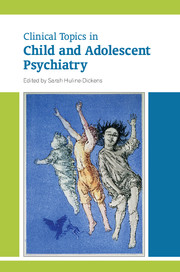Book contents
- Frontmatter
- Contents
- List of tables
- List of boxes
- List of figures
- List of contributors
- Preface
- 1 Child psychiatry and the people who have shaped it
- 2 Fabrication and induction of illness in children
- 3 Personality disorders as disorganisation of attachment and affect regulation
- 4 Post-traumatic stress disorder and attachment: possible links with borderline personality disorder
- 5 Management of antisocial behaviour in childhood
- 6 Pharmacology for attention-deficit hyperactivity disorder, Tourette syndrome and autism spectrum disorder
- 7 Pharmacology for anxiety and obsessive–compulsive disorders, affective disorders and schizophrenia
- 8 Pharmacological management of core and comorbid symptoms in autism spectrum disorder
- 9 Pharmacological treatment of depression and bipolar disorder
- 10 Cognitive–behavioural therapy with children, young people and families: from individual to systemic therapy
- 11 Anxiety disorders
- 12 Somatising: clinical presentations and aetiological factors
- 13 Somatising: management and outcomes
- 14 Evaluating psychological treatments for children with autism
- 15 Attention-deficit hyperactivity disorder: assessment and treatment
- 16 Schizophrenia
- 17 Tourette syndrome
- 18 Sleep disorders
- 19 Self-harm in adolescents
- 20 Adolescent substance misuse: an update on behaviours and treatments
- 21 Eating disorders
- 22 Gender dysphoria in young people
- 23 The psychiatry of children aged 0–4
- Index
10 - Cognitive–behavioural therapy with children, young people and families: from individual to systemic therapy
Published online by Cambridge University Press: 02 January 2018
- Frontmatter
- Contents
- List of tables
- List of boxes
- List of figures
- List of contributors
- Preface
- 1 Child psychiatry and the people who have shaped it
- 2 Fabrication and induction of illness in children
- 3 Personality disorders as disorganisation of attachment and affect regulation
- 4 Post-traumatic stress disorder and attachment: possible links with borderline personality disorder
- 5 Management of antisocial behaviour in childhood
- 6 Pharmacology for attention-deficit hyperactivity disorder, Tourette syndrome and autism spectrum disorder
- 7 Pharmacology for anxiety and obsessive–compulsive disorders, affective disorders and schizophrenia
- 8 Pharmacological management of core and comorbid symptoms in autism spectrum disorder
- 9 Pharmacological treatment of depression and bipolar disorder
- 10 Cognitive–behavioural therapy with children, young people and families: from individual to systemic therapy
- 11 Anxiety disorders
- 12 Somatising: clinical presentations and aetiological factors
- 13 Somatising: management and outcomes
- 14 Evaluating psychological treatments for children with autism
- 15 Attention-deficit hyperactivity disorder: assessment and treatment
- 16 Schizophrenia
- 17 Tourette syndrome
- 18 Sleep disorders
- 19 Self-harm in adolescents
- 20 Adolescent substance misuse: an update on behaviours and treatments
- 21 Eating disorders
- 22 Gender dysphoria in young people
- 23 The psychiatry of children aged 0–4
- Index
Summary
Cognitive–behavioural therapy (CBT) is fundamentally a collaborative, empirical process of shared discovery (Salkovskis, 2002) in which client and therapist together derive a hypothesis, the ‘formulation’ (Persons, 1989), about the aetiology and maintenance of the client's problem. This formulation encompasses the unique predicament and response of the client in their particular present and past life contexts. This hypothesis is continuously refined in therapy as the client tests its validity against their experience and uses it to select cognitive and behavioural interventions. Instead of giving solutions, the therapist's emphasis is on guided discovery using Socratic dialogue (Padesky & Greenberger, 1995) and systematic use of case-specific and standardised ratings to promote self-help and problem-solving. Failure to appreciate that therapy is explicitly based on a shared formulation, rather than being a collection of techniques, has resulted in a disparate range of interventions being used as ‘CBT for children’ (Stallard, 2002). There is now widespread appreciation of the need to define CBT for children, young people and families and, in particular, to ensure that interventions are formulation based (an opinion confirmed at the inaugural meeting of the Child and Adolescent Special Interest Branch of the British Association for Behavioural and Cognitive Psychotherapies (BABCP) in 2001).
By ‘children and young people’ we mean individuals up to the age of 18. For conciseness in this chapter we refer to them simply as children.
The evidence base
A significant body of evidence supports the use of CBT to treat a wide range of child and adolescent mental health problems such as depression (Harrington et al, 1998; March et al, 2004), generalised anxiety (Barrett et al, 2001), conduct disorder (White et al, 2003), interpersonal problems (Spence & Donovan, 1998), phobias (Silverman et al, 1999), social phobia (Spence et al, 2000), school refusal (King et al, 1998), sexual abuse (Jones & Ramchandani, 1999), pain management (Sanders et al, 1994), eating disorders (Schmidt, 1998), post-traumatic stress disorder (Smith et al, 1998) and obsessive–compulsive disorder (Barrett et al, 2005).
- Type
- Chapter
- Information
- Clinical Topics in Child and Adolescent Psychiatry , pp. 150 - 164Publisher: Royal College of PsychiatristsPrint publication year: 2014

